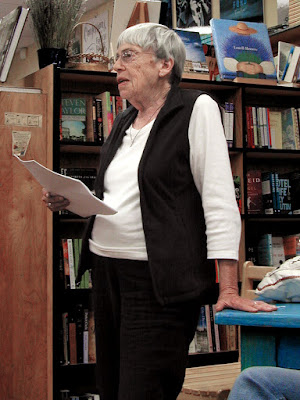One post from the Twitter feed that grabbed my attention this week was a quote from fantasy writer Ursula K. Le Guin: "The story is not in the plot but in the telling." Because the quote resonated so much with me, and because I'd heard of Le Guin many times but didn't actually know much about her, I decided to begin with her for this Wikipedia Trails project.
Ursula K. Le Guin
An active author since the early 1960s, Le Guin has become one of the most awarded, influential writers in the fields of fantasy and science fiction. Though I'd heard about her Earthsea from many different sources, that was about the extent of my knowledge about her, so I was surprised to learn what a long career she's had and how many people her work has shaped. By now, she's influenced four generations of readers and other writers, including Neil Gaiman and Salman Rushdie. Though her list of awards and accomplishments is definitely nothing to overlook, it's that legacy—the footprint she's left in the field of storytelling—that impressed me the most. Part of what inspired Le Guin to explore the complexities of culture in her work was the fact that her anthropologist father and his circle of friends studied the Native American man Ishi, who was known as "the last wild Indian," as he navigated modern life. I decided to learn more about him.
Ishi
After surviving disease, bounty attacks, and the Three Knolls Massacre of 1865, Ishi was eventually left as the last living member of the Yahi people of California. Once he lost the few remaining members of his people, he lived alone in the wilderness for four years before heading to a town in California in an attempt to find food. Word spread about him quickly, and when the University of California found out about him, they brought him on as a research assistant at the university, where he also lived and was studied. In the five years between his arrival at the school and his death by tuberculosis, he helped anthropologists understand and record information about the Yahi culture.
California Gold Rush
The California Gold Rush made life much more difficult for Ishi and his family, but it led me to the third stop on my Wikipedia trail. This era of quick growth and sweeping migration has always caught my imagination, but I was interested to learn that many of those who rushed in to pan for gold actually came from different countries and continents. Searching for gold also became a family affair for some: the women brought in steady incomes, which gave their husbands the chance to try to find gold.
Ghost Towns
After the gold fever passed and opportunities dried up, some of the boomtowns became ghost towns instead. Although ghost towns themselves don't represent anything new to most people, I was intrigued to learn about a handful of former ghost towns that have actually been resettled—either as tourist towns due to interest generated by their status as ghost towns, or simply due to availability and proximity to more in-demand locations. One of these revived ghost towns is Walhalla in Victoria, Australia, pictured above.
Image Credits:
Ursula K. Le Guin giving a reading at Danville, California, in 2008. Source: Wikimedia Commons.
Photograph of Ishi. Source: Wikimedia Commons.
San Francisco in 1851, during the Gold Rush. Source: Wikimedia Commons.
A revived ghost town of Walhalla, Victoria, Australia, including original and newly reconstructed buildings. Source: Wikimedia Commons.




No comments:
Post a Comment